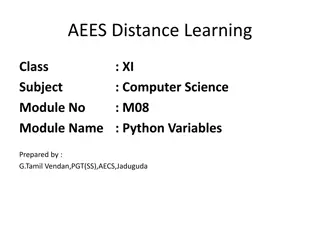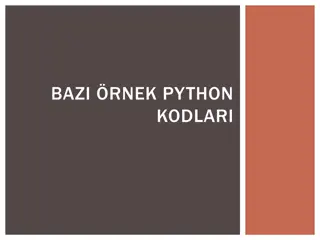
Advanced Python Concepts and Logic Gates in Digital Circuits
Explore advanced Python concepts such as conditionals, return values, and logical operators, along with an introduction to logic gates as the building blocks of digital circuits. Understand how to use conditionals effectively with examples and learn about comparison and logical operators. Dive into a comprehensive overview of Python programming combining real-world applications and theoretical foundations.
Download Presentation

Please find below an Image/Link to download the presentation.
The content on the website is provided AS IS for your information and personal use only. It may not be sold, licensed, or shared on other websites without obtaining consent from the author. If you encounter any issues during the download, it is possible that the publisher has removed the file from their server.
You are allowed to download the files provided on this website for personal or commercial use, subject to the condition that they are used lawfully. All files are the property of their respective owners.
The content on the website is provided AS IS for your information and personal use only. It may not be sold, licensed, or shared on other websites without obtaining consent from the author.
E N D
Presentation Transcript
Lab #5-6 Follow-Up: More Python; Images
Part 1: Python Conditionals, Return Values, and Lists
Conditionals: General Form if <CONDITION> : <statement> <statement> ... <statement> elif <CONDITION> : <statement> ... <statement> elif ... else: <statement> ... <statement>
Example if IQ > 140: elif IQ > 130: print("Wicked smaht!") elif IQ > 120: print("Way above average.") elif IQ > 110: print("Still no slouch.") elif IQ > 100: print("College material.") elif IQ > 90: print("Hope springs eternal!") else: print("Dude, where's my car?") print("OMG genius!")
Comparison Operators x > y x < y x >= y x <= y x != y # x greater than y # x less than y # x greater than or equal to y # x less than or equal to y # x not equal to y
Logical / Boolean Operators x > y and y > z x > y or y > z not (x > y) G. Boole (1815-1864)
Logic Gates: The Building Blocks of Digital Circuits http://volga.eng.yale.edu/uploads/Main/gate-symbols.png
Logic Gates: The Building Blocks of Digital Circuits http://cpuville.com/logic_gates.htm http://volga.eng.yale.edu/uploads/Main/gate-symbols.png resistor transistor
Putting It All Together # The grading scale will be 93-100 A; 90-92 A-; 87-89 B+; # 83-86 B; 80-82 B-; 77-79 C+; 73-76 C; 70-72 C-; # 67-69 D+; 63-66 D; 60-62 D-; below 60 F. if average >= 93 and average <= 100: grade = 'A' elif average >= 90 and average <= 92: grade = 'A-' elif average >= 87 and average <= 89: grade = 'B+' elif average >= 83 and average <= 86: grade = 'B' elif average >= 80 and average <= 82: grade = 'B-' . . . elif average < 60: grade = 'F'
Less Is More! # The grading scale will be 93-100 A; 90-92 A-; 87-89 B+; # 83-86 B; 80-82 B-; 77-79 C+; 73-76 C; 70-72 C-; # 67-69 D+; 63-66 D; 60-62 D-; below 60 F. if average >= 93: grade = 'A' elif average >= 90: grade = 'A-' elif average >= 87: grade = 'B+' elif average >= 83: grade = 'B' elif average >= 80: grade = 'B-' . . . else: grade = 'F'
if average >= 93: grade = 'A' elif average >= 90: grade = 'A-' elif average >= 87: grade = 'B+' elif average >= 83: grade = 'B' elif average >= 80: grade = 'B-' . . . else: grade = 'F' Dimes Pennies Nickels Quarters
Returning Values from Functions For many robot applications, functions just need to cause side-effects: def wiggle(speed, waitTime): rotate(-speed) wait(waitTime) rotate(speed) wait(waitTime) stop() Outside of robotics, functions are described by what value they return as well .
Returning Values from Functions def square(x): return x * x # without square(), we'd have to do this: dst = sqrt((x1-x2)*(x1-x2) + (y1-y2)*(y1-y2)) # instead of this: dst = sqrt(square(x1-x2) + square(y1-y2))
Multiple return points def absoluteValue(x): if x < 0: return x elif x > 0: return x elif x == 0: return 0
Less is more! def absoluteValue(x): if x < 0: return x else: return x
Putting it all together: Writing our own sqrt()function For perfect squares (0, 1, 4, 9, 16, 25, ) , we typically just memorize them For other numbers, we need a function: from math import sqrt How does sqrt() work? E.g., what is sqrt(3) ?
Putting it all together: Writing our own sqrt()function How does sqrt() work? E.g., what is sqrt(3) ? It must be between 0 and 3, since a square root can't be negative, and a number can't be bigger than its own square root (?) So our first approximate could just be the average of 0 and 3: (0 + 3) / 2 = 1.5 But 1.5 * 1.5 = 2.25, which is less than 3 So the square root must lie between 1.5 and 3 (1.5 + 3) / 2 = 2.25; 2.25 * 2.25 = 5.0625, too big! So the square root must lie between 1.5 and 2.25 Et cetera
Putting it all together: Writing our own sqrt()function Algorithm for computing the square root of a number N: 1. 2. 3. 4. Start with a lower bound of zero and an upper bound equal to N While the square of their mean is too far from N, do the following: If squared mean is too big, use mean as the new upper bound Otherwise, use mean as new lower bound What haven't we considered?
PRECISION = 0.000001 def mysqrt(n): if n < 1: lower = n upper = 1 else: lower = 1 upper = n while True: mean = (lower + upper) / 2.0 meansqr = mean * mean if abs(meansqr-n) < PRECISION: return mean if meansqr > n: upper = mean else: lower = mean
Python Lists Computer Science consists mainly in 1. Putting data into lists 2. Sorting the lists according to some criterion (e.g. alphabetical order) 3. Searching the sorted list to find an item of interest For sorting and searching to be efficient, the lists must support random access : like RAM (vs. sequential access of disk, one byte at a time) Python lists provide all these features for us Python's range() function generates numerical lists of arbitrary size
Self-Test: Predict the result of each print() family = ['Simon', 'Linda', 'Sam'] print(family[0]) # random access print(family[1]) print('Simon' in family) # search print('George' in family) cousins = ['Stephanie', 'Susan', 'Michael'] print(family + cousins) family.sort() print(family) print(len(family)) family.append('Sharon') print(family) family.reverse() print(family) for person in family: print(person)
Self-Test: Predict the result of each print() for k in range(5): print(k) for k in range(3,7): print(k) for k in range(1,10,2): print(k)






















